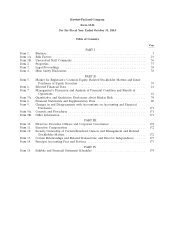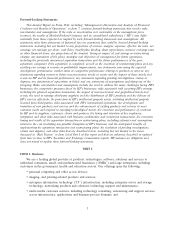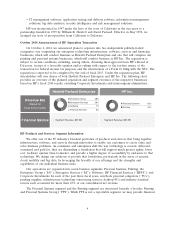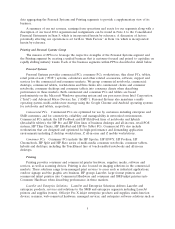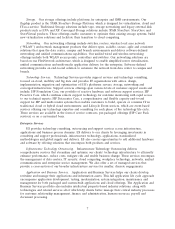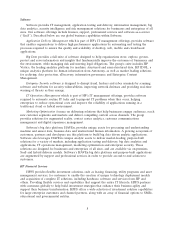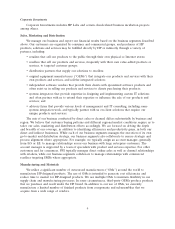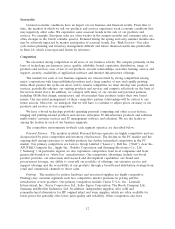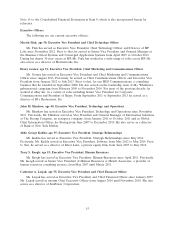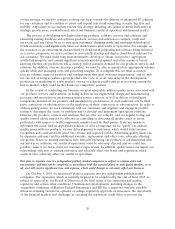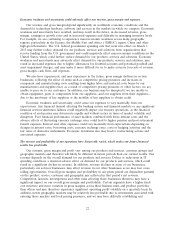HP 2014 Annual Report Download - page 20
Download and view the complete annual report
Please find page 20 of the 2014 HP annual report below. You can navigate through the pages in the report by either clicking on the pages listed below, or by using the keyword search tool below to find specific information within the annual report.Seasonality
General economic conditions have an impact on our business and financial results. From time to
time, the markets in which we sell our products and services experience weak economic conditions that
may negatively affect sales. We experience some seasonal trends in the sale of our products and
services. For example, European sales are often weaker in the summer months and consumer sales are
often stronger in the fourth calendar quarter. Demand during the spring and early summer months also
may be adversely impacted by market anticipation of seasonal trends. See ‘‘Risk Factors—Our sales
cycle makes planning and inventory management difficult and future financial results less predictable,’’
in Item 1A, which is incorporated herein by reference.
Competition
We encounter strong competition in all areas of our business activity. We compete primarily on the
basis of technology, performance, price, quality, reliability, brand, reputation, distribution, range of
products and services, ease of use of our products, account relationships, customer training, service and
support, security, availability of application software and internet infrastructure offerings.
The markets for each of our business segments are characterized by strong competition among
major corporations with long-established positions and a large number of new and rapidly growing
firms. Most product life cycles are short, and to remain competitive we must develop new products and
services, periodically enhance our existing products and services and compete effectively on the basis of
the factors listed above. In addition, we compete with many of our current and potential partners,
including OEMs that design, manufacture and often market their products under their own brand
names. Our successful management of these competitive partner relationships will be critical to our
future success. Moreover, we anticipate that we will have to continue to adjust prices on many of our
products and services to stay competitive.
We have a broad technology portfolio spanning personal computing and other access devices,
imaging and printing-related products and services, enterprise IT infrastructure products and solutions,
multi-vendor customer services and IT management software and solutions. We are the leader or
among the leaders in each of our business segments.
The competitive environments in which each segment operates are described below:
Personal Systems. The markets in which Personal Systems operates are highly competitive and are
characterized by price competition and inventory obsolescence. The decline in the PC market and the
ongoing shift among customers to mobility products has further intensified competition in the PC
market. Our primary competitors are Lenovo Group Limited (‘‘Lenovo’’), Dell Inc. (‘‘Dell’’), Acer Inc.,
ASUSTeK Computer Inc., Apple Inc., Toshiba Corporation and Samsung Electronics Co., Ltd.
(‘‘Samsung’’). In particular regions, we also experience competition from local companies and from
generically-branded or ‘‘white box’’ manufacturers. Our competitive advantages include our broad
product portfolio, our innovation and research and development capabilities, our brand and
procurement leverage, our ability to cross-sell our portfolio of offerings, our extensive service and
support offerings and the accessibility of our products through a broad-based distribution strategy from
retail and commercial channels to direct sales.
Printing. The markets for printer hardware and associated supplies are highly competitive.
Printing’s key customer segments each face competitive market pressures in pricing and the
introduction of new products. Our primary competitors include Canon U.S.A., Inc., Lexmark
International, Inc., Xerox Corporation Ltd., Seiko Epson Corporation, The Ricoh Company Ltd.,
Samsung and Brother Industries, Ltd. In addition, independent suppliers offer refill and
remanufactured alternatives for HP original inkjet and toner supplies, which are often available for
lower prices but generally offer lower print quality and reliability. Other competitors also have
12


